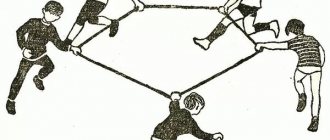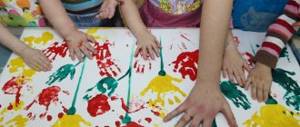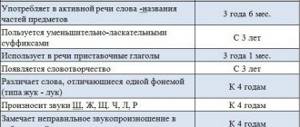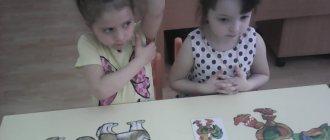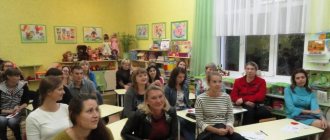Finger gymnastics and its meaning
Finger gymnastics is a set of exercises aimed at developing fine motor skills of the hands. The value of finger gymnastics is that by developing children’s hands, we stimulate the development of students’ speech. Manual actions (that is, actions with the hands) affect certain areas of the cerebral cortex, where the centers responsible for the production (in the frontal lobe - Broca's area) and understanding (in the parietal - Wernicke's area) of speech are located.
Speech centers of the brain
Numerous studies in the field of neurolinguistics and neurophysiology indicate a direct dependence of the level of speech development on the extent to which finger movements and fine motor skills are involved in the educational process. Speech therapists use finger gymnastics exercises to correct children's speech. Eastern doctors claim that by influencing certain areas of the hands, one can influence the functioning of the human internal organs associated with them. For example, massaging the thumb stimulates the brain, and the ring finger stimulates the liver and kidneys.
Goals and objectives of finger gymnastics
So, finger gymnastics is a multi-purpose set of exercises with which you can simultaneously develop hand motor skills, speech, as well as imagination and memory. The goals of finger gymnastics classes in kindergarten are as follows:
- development of fine motor skills and coordination of finger movements;
- improving the articulation of sounds and the formation of speech rhythms;
- development of higher psychological functions:
- thinking;
- speeches;
- perception;
- memory;
- imagination;
When conducting finger gymnastics classes with children aged three to four years, the teacher must solve the following tasks:
- develop fine movements of the fingers, as well as synchronization of the actions of the fingers of both hands;
- combine manual and speech actions;
- develop the higher psychological functions of children through repetition and memorization of rhymes used in this kind of games, as well as through visualization of the game text;
- to develop children’s interest in games of this kind;
- apply folklore material in work, which will contribute to the education and development of the individual within the framework of given cultural traditions.
The goals and objectives of finger gymnastics exercises can be adjusted depending on the physical and mental development of children.
Why are finger games needed?
The main goal of finger games is to develop fine motor skills of the hands.
This is necessary for the development of speech, strengthening the muscles of the hands, so that the child can hold a pen firmly and develop good handwriting. They also help improve the child’s dexterity and mobility, improve coordination and reaction speed. Children who are regularly involved in finger games develop their creative abilities and communication skills better. They are more attentive and emotionally stable, and calm down faster. In addition, finger games are a great way to cheer up your baby and distract him for a change of activity.
Carrying out finger gymnastics is based on the child’s desire to imitate adults. He carefully watches their movements and tries to copy their speech. The baby can easily learn many rhymes that need to be said during games by heart, which helps train his memory.
To achieve the listed results, you should follow the main rule of training sessions with young children - regularity. Finger gymnastics for children 3-4 years old in kindergarten must be performed daily. The duration of the lessons is about 5 minutes. Make sure your child is not distracted by other activities, but remember not to force them to do the exercises. This is a game! Therefore, it should take place in a fun, relaxed atmosphere.
How to effectively perform finger gymnastics
When working with children, their interest in performing certain actions is important. The peculiarity of finger gymnastics is that it is always a game, and children love to play, so there should be no problems with performing the exercises. Finger gymnastics can be done individually or with a group of children. The time for gymnastics may vary depending on the type of game (on average, games last from three to five minutes). If the game takes a short amount of time and is well known to children, then you can complete its task during walks and in breaks between classes.
Before starting the exercises, you need to prepare your children's hands: warm them up. To do this, you can gently rub your hands together or stroke them. After our hands are ready, we need to start the gymnastics itself.
There are many finger gymnastics exercises based on manipulation of small objects (pencils, threads, cubes, balls, etc.)
When performing finger gymnastics, the following methods are used:
- showing actions;
- actions with the child's hands;
- independent actions of the child.
Finger gymnastics begins with the teacher introducing the children to the rules of the game, the text of the exercise and handouts, if any. Next, the teacher himself begins to complete the task, reciting the text of the game (poem, counting rhyme, etc.), and the children begin to repeat. With children of the second youngest group, you can learn poems and songs in advance, look at illustrations, discuss and retell the texts necessary for classes.
Tips for performing finger gymnastics:
- The teacher should slowly and clearly pronounce the words of the poem (counting books, etc.), focusing on difficult-to-pronounce sounds (the tempo can be increased over time).
- Watch the correctness of your movements (they repeat after you!) and the placement of the children’s fingers.
- When performing the exercises, all fingers of both hands should be used.
- Repeat each exercise 2-3 times.
- Use accompaniment, illustrations, videos (this will contribute to the overall development of the child).
- Choose games that use all the movements of the hand (compression, extension, work of each finger).
- Use a variety of exercise types.
When performing finger gymnastics, it is recommended to use visual material. This will contribute to the development of children's imagination and imaginative thinking. For clarity, the following can be used: drawings, toys, colored paper, an interactive whiteboard, etc. For example, in the “Toys” exercise presented below, you can use either pictures of these toys or real toys. In the game “Wind” (see below), it would be good to use animation (build a video sequence that corresponds to the text of the game). Many finger gymnastics games are focused on the use of musical accompaniment (for example, “At the Deer”), which contributes to the development of rhythm and musical ear in students.
Table: summary of the lesson “Playing with our fingers” for the second junior group, author Oksana Demidova
| Name | "We play with our fingers" |
| Description | The lesson is aimed at children of the second junior group and includes elements of musical and theatrical activities. Complies with state educational standards (FSES). Age group: second youngest group (3–4 years). Lesson duration: 15 minutes. Form of organization: subgroup. Facilities:
|
| Goals and objectives |
|
| Preliminary work | Learning finger and speech games using technical means. (Educational program on discs “Get ready to exercise”, “Finger gymnastics”).
|
| Motivational part | Children sit on chairs. Educator: Guys, we have good friends. They know how to play and put away toys, and they know how to wash themselves. They can also clap loudly! What kind of friends are these? Children: Palms and fingers! Educator: Yes, these are our palms and fingers. Raise them high. Let's show what they can do. Let's play the finger game “How are you?” - How are you? - Like this (thumb forward) - How do you swim? - Like this (imitation of swimming) - How do you run? - Like this (running fingers) - Are you looking into the distance? - Like this (hand to forehead) - How do you eat? - Like this (imitation of eating with a spoon) - How do you sleep? - Like this (imitation of sleep) - How do you inflate a balloon? - Like this (imitation of inflating a balloon; the balloon burst - show with your cheeks) - How are you being naughty? - Like this (imitation of a clown tease) Educator: Guys, let's tell you who you live with at home? Children perform finger gymnastics “My Family”: This finger is mommy, This finger is daddy, This finger is grandfather, This finger is grandmother, This finger is me, That’s my whole family! Educator: Well done! Do you want to know what else your fingers can do? Children: Yes! Educator: Then we'll go on a trip! But first you need to prepare for it. Children perform the game exercise “Are you ready?” -Are you ready, little eyes? Children: Yes! (shows eyes) - Are you ready, ears? Children: Yes! (show ears) - Are you ready, hands? Children: Yes! (show hands) - Are you ready, legs? Children: Yes! (stomp their feet) - Are you ready? Children: Yes! (hug themselves with their arms) Educator: Well done, guys. Well prepared. Now let's get on the train and hit the road. |
| Organization of children's productive activities | Game with onomatopoeia: “Train” Chug-chug-chug! The train is rushing at full speed! Let's go (sh-s-sh-s) The steam locomotive is humming (oo-oo-oo) Steam is blowing (p-p-p) Stopped (ff-ff) Teacher and children together: We've arrived! Educator: Guys, where have we come? Children: To a fairyland. Educator: Who is meeting us? Children: Pussy! Educator: She’s sad, did something happen to her? Let's ask the pussy! Children: Pussy, what happened to you? Pussy - a soft toy (voiced by an adult): I was going for a walk with my little children, Andryushka came running, tugging at our ears! Meow! Meow! My kids were very scared! Educator: Don’t cry, pussy, our guys are kind. They will be sorry and pet your children. Guys, what do you call the little children of a mother cat? Children: Kittens. Educator: What does a mother cat call her kittens? Children: Meow! (loudly) Teacher: How do the kittens answer her? Children: Meow! (quietly) Educator: Let's take the kittens in our arms, hug them affectionately, and stroke them. Let's say: head, back, tail. (Children perform the reenactment “Pet the cat”). Educator: Let's release the kittens, let them run home to their mother cat. Pussy: Thank you guys. You are very kind and love animals very much. Children: Goodbye, pussy! |
| Surprise moment | Educator: What kind of miracle box has appeared in our group? Let's open it. (Open the box, a frog jumps out). Educator: Who is this, guys? Children: Frog. Educator: How does she scream? Children: Kva-kva-kva! Educator: What fairy tale did she come from? Children: From the fairy tale “Teremok”. Educator: She probably got lost. She went to the teremok and ended up in our kindergarten. Let us help her find her way home. Let's tell her the fairy tale "Teremok". (Physical education lesson - fairy tale "Teremok") Educator: Guys, let's see what else we have in the box? (Pulls out the grandfather and grandmother and the turnip) Guys, let’s help the grandfather and grandmother pull out the turnip. Performed by ri Educator: For grandparents, let's chop cabbage. Finger gymnastics “Cabbage” Teacher (takes ribbons out of the box according to the color of the rainbow): Guys, look at the multi-colored ribbons in the box. What are they like? Children: To the rainbow. Educator: Let's dance with them. (A dance with ribbons is performed). |
| Independent activities of children | At the end of the ribbon dance, the children make a rainbow. Educator: That's what a rainbow we got! |
| Summarizing | “Guys, did you like playing with your fingers? What did you like most?” (children's answers) |
| Quote from: https://www.maam.ru/detskijsad/konspekt-zanjatija-na-temu-igraem-nashimi-palchikami-dlja-vtoroi-mladshei-grupy.html | |
Types of finger gymnastics for younger children
Finger gymnastics in the younger group is carried out in the form of a finger game, playing out a fairy tale or nursery rhyme, since ordinary gymnastics, consisting of exercises for the fingers and palms, is still uninteresting and incomprehensible to children.
For children of the third year of life, the most suitable type of games is imitation, in which they imitate animals, fairy tale characters and their actions . For example: “The bun rolled along the path, funny people are running along the path, a bunny is jumping, a bird is flying.”
Manipulation games involving performing certain actions are also popular. They use specially prepared aids (laces, clothespins, caps) with fields to which they are attached. Manipulation includes playing with small objects such as balls, chestnuts, and burying and searching for objects in containers containing bulk materials such as sand or cereal.
There are a number of manipulative games without objects, in which the child needs to perform actions only with his fingers, focusing on the text spoken by the teacher: “This finger is a grandfather,” “The fingers went for a walk.”
From the second half of the year, finger theater can be introduced, acting out a small work or fragment of a favorite fairy tale with the help of finger puppets and small paraphernalia . And even though children cannot yet properly handle puppets or pronounce the words of the roles, looking at theater puppets and performing simple actions with them will be the first step to mastering the art of dramatization.
A finger theater based on a favorite fairy tale will certainly arouse great interest among children
Finger games for children 3–4 years old
Finger gymnastics can be integrated organically into almost any activity.
Table: exercise “Fingers”
| Text | Action |
This exercise will help you work each finger separately.
| |
| This finger wants to sleep | We bend the little finger with our right hand and move to the ring finger. |
| This finger is a jump into bed, | We bend the nameless one. |
| This finger took a nap | We bend the middle one. |
| This finger has already fallen asleep, | Bend the index finger. |
| Hush little finger, don't make noise, don't wake up your brothers! | We work with the thumb of the left hand, pronounce it in a whisper. |
| Fingers stood up, hurray, it's time to go to kindergarten! | We pronounce it cheerfully, clenching and unclenching our fists. |
Video: finger gymnastics “The sun has risen”
Text:
- Morning has come. The sun has risen. - Hey, brother Fedya, wake up the neighbors! - Get up, Bolshak! - Get up, Pointer! - Get up, Seredka! - Get up, Orphan! - And Little Mitroshka! - Hello, Ladoshka! Everyone stretched and woke up.
Table: finger gymnastics “Wind”
| Text | Action |
| The wind blows, blows, | Blow on your palms. |
| The palm tree shakes to the sides, | Depict a swinging tree (pull your arms up and wave them). |
| And under the palm tree the crab sits and moves its claws. | Move your fingers. |
| A seagull flies over the water | The hands are crossed; wave them. |
| And he dives for fish. | The palms are folded into a boat and pressed against each other; perform diving movements with them. |
| Underwater at depth | The hands are pressed at the base, the palms are facing each other, the fingers are bent. |
| The crocodile lies at the bottom. | Open and close the crocodile's mouth. |
Table: finger gymnastics “Toys”
| Text | Action |
| On a large sofa, Katina's dolls are sitting in a row: | They alternately clap their hands and bang their fists. |
| And the bear, and Pinocchio, and the cheerful Cipollino, and the kitten, and the baby elephant. | Bend all the fingers on one hand one by one |
| One two three four five, | Extend your fingers one by one. |
| Let's help our Katya count the toys. | They alternately clap their hands and bang their fists. |
When playing the game, it is recommended to use toys or pictures.
Table: finger gymnastics “Kolobok - ruddy side”
| Text | Action |
| Kolobok - ruddy side, rolled off the threshold! | The left hand lies on the table, palm up. Using the right palm, we “roll” the ball in a circular motion - we move it over the left palm. |
| Skok-skok, skok-skok, Rolled over the threshold! | Clench your right palm into a fist and, syllable by syllable with slight pressure, “walk” the fist, like a hammer, along the fingertips of your left hand. On the sixth syllable, “knock” your fist into the middle of your palm, ending with circular movements. |
| Kolobok rolled along the path into the woods! Skok-skok, skok-skok, Along the path into the woods! | Change hands and perform the movements from the previous part. |
| He met a little hare in the forest, | With two fingers of each hand we depict the “ears” of a bunny, slightly bending and unbending - the index and middle fingers are raised up, the rest are pressed to the palm. |
| And the toothy Wolf Cub, | “Intimidatingly” we squeeze and unclench all the fingers on both hands. |
| A clubfoot bear. | Clench your fists and stomp on the table word by word. |
| And the Chanterelle Kolobok Grab it! She took it and grabbed it! | Quickly join the fingers of both hands into a lock. |
Table: finger gymnastics “Snowball”
| Text | Action |
| One, two, three, four, you and I made a snowball. | We show you how to sculpt with your palms. |
| Round, strong, very smooth and not at all sweet. Once - we'll throw it up. | We raise our hands up. |
| Two - we'll catch it. | We press our hands to our chest as if we caught a ball. |
| Three - we'll drop it. And... we'll break it. | We lower our hands down. |
Table: finger gymnastics “Snowflake”
| Text | Action |
| I stand and catch snowflakes in my palm. | Rhythmic strikes with the fingers of the left hand, starting with the index finger, on the palm of the right hand. |
| I love winter, and snow, and snowflakes. | Rhythmic strikes with the fingers of the right hand, starting with the index finger, on the palm of the left hand. |
| But where are the snowflakes? | When asked, clench your fists. |
| There is water in the palm. | Unclench your fists. |
| Where have the snowflakes gone? Where? | At the first question, clench your fists, at the second, unclench your fists. |
| The fragile pieces of ice-rays have melted... As you can see, my palms are hot. | Small shaking with relaxed palms. |
Table: finger gymnastics “Maple”
| Text | Action |
| Outside the window the icicle is melting, the wind is tearing the clouds to shreds. | Clench and unclench your palms. |
| Maple unclenches and unclenches his tight fists. | Place your fingers in a “lock” and forcefully pull your arms in different directions. |
| He leaned against the window, And as soon as the snow melted, | The fingers “hello” the thumb twice each, starting with the index finger. |
| Maple will give me his green palm before anyone else. | Shake your hands, fingers up. |
Table: finger gymnastics “Kolobok”
| Text | Action |
| I am a bun, a bun, | Roll an imaginary bun in your hands. |
| Scratched the bottom of the barrel, | The right palm is scraped on the left palm. |
| Swept across the barn, | Simulates sweeping the floor. |
| Mixed with sour cream, | Make circular movements with your right hand. |
| Sat in the oven, | Show both arms extended forward. |
| It's cold at the window, | Draw a window with your hands. |
| I left my grandmother, I left my grandfather. | Touch with index and middle fingers (“walk” with fingers) |
Table: finger gymnastics “At the Deer”
| Text | Action |
| At the Deer's | We depict horns by placing our hands to the head with fingers spread out |
| House | We connect the tips of our fingers on our palms at an angle, depicting a roof over our head. |
| Big, | We spread our arms to the sides, showing how big his house is |
| He looks out his window. | We hold one hand horizontally at chest level, support the head with the palm of the second hand, and the elbow rests on the first hand. |
| A bunny runs through the forest | We use our fingers to depict a running hare. |
| There’s a knock on his door: “Knock, knock, open the door.” | We pretend to knock on the door. |
| There in the forest | We point over the shoulder behind the back with the thumb of the fist. |
| Hunter | We show how a hunter takes aim with a gun. |
| Wicked! | We make a scary face. |
| - Hurry up and run | We simulate the opening of a door. |
| Give me your paw. | We shake the baby's hand. |
The game involves the use of musical accompaniment (it will be very good if the accompanist catches the tempo set by the children). We sing the words and repeat the exercise several times, increasing the tempo.
How to properly conduct finger gymnastics classes in kindergarten
A successful result of the lesson will be achieved by following the following rules:
- preliminary training of a teacher, compiling or purchasing a card index of finger games;
- attracting the attention of children (“a bear or a doll came to visit us”), a fairy-tale introduction;
- speech accompaniment can be poems and nursery rhymes, descriptions of actions in prose;
- first you need to warm up your hands, rub your palms until you feel warm;
- repeat exercises no more than five times;
- the teacher slowly shows the movements and does them together with the children, making sure they are performed correctly;
- friendly attitude of the teacher, maintaining a good mood in children;
- quiet musical accompaniment;
- gradually memorize the accompanying verses.
Ready-made cards with finger games are useful for educators and parents; they are convenient to take on walks and trips with children.
Example of a lesson summary
Below is a summary of a finger gymnastics lesson in the middle group “Morning Greeting”.
Goals:
- development of fine motor skills through finger exercises;
- improving speech skills; study of body parts;
- development of thinking, imagination, coordination of movements;
- creating a positive mood for the whole day.
The teacher greets the children. He asks if they slept well, what their mood is: Did our fingers wake up? Let's wake them up!
Morning has come, the sun has risen!
Get up, big guy! (with the fingers of one hand we bend and stretch the fingers of the other, clenched into a fist - starting with the thumb)
Get up, pointer! (bend the index finger)
Get up, middle! (bend and stretch the middle finger)
Get up, little orphan! (we work with the ring finger)
Get up, little one! (little finger)
We repeat the exercises for the other hand.
Educator: fingers woke up! What about eyes, ears, legs?
Wake up, my little eyes! (imitation - twist the binoculars, focus)
Wake up, my ears! (stroked, kneaded with fingers, rubbed the lobe with the index and thumb)
Wake up, my hands! (patted from shoulder to hand, clapped hands)
Wake up, my legs! (patted, stomped)
Wake up, head! (pat yourself on the head)
Now I'm all awake! (reached up, clapped and waved their palms in greeting)
Finger gymnastics in the middle group - a card index with goals for the Federal State Educational Standard for the year
Educational activities in preschool institutions are based on the requirements of the Federal State Educational Standard (FSES) (Federal State Educational Standards). Aimed at child development and preparation for school.
A set of exercises by month.
Goals:
- develop speech, form correct sound pronunciation, the ability to speak quickly and clearly;
- develop coordination of hand movements, train fine motor skills;
- improve memory, attention, ability to coordinate movements and speech.
| Months | Subject | Exercises |
| January | Seasons Holiday New Year | “Snowballs” “Herringbone” “Snowman” |
| February | February 23 Toys Animals | “We are soldiers” “Toys” “Hello, chicken!” |
| March | March 8 Professions Fruits | “Mom’s Day” “All sorts of mothers are needed” “Nuts” |
| April | Seasons Birds | "The Tree Sways" »Sparrows« |
| May | Seasons May 9 “Clothing” | "Spring" "Planes" "Matryoshka" |
| June | Nature Flowers Toys | “Tree” “Our red flowers” “Ball” |
| July | Vegetables Nature | “Cooking Soup” “Our Vegetable Garden” |
| August | Weather Shoes Berries | “Rain” “Boots” “In the Garden” |
| October | Dishes Seasons Vegetables | “Plates” “Drip-Drip” “We salt the cabbage” |
| november | Toys Clothes Animals | “Doll” “Boots” “Snail” |
| December | Seasons Games Products | “Winter” “Winter fun” “Pie” |
Visual aid for the game “Snail”
The importance of finger exercises for the development of preschool children
Finger games and finger gymnastics are a type of children's motor activity, the main goals of which are:
- development of fine motor skills of the hand, palm and fingers;
- improvement and enrichment of tactile sensations;
- development of skills to manipulate small objects and perform actions with them.
Unlike games, finger gymnastics has a clearer, fixed structure, involves performing actions in a certain order, according to the model shown by the teacher, and includes elements of self-massage. But since finger games are exciting, dynamic and have a great influence on the development of the emotional sphere of preschoolers, they can also be used during organized educational activities as a type of light gymnastics for the palms and fingers.
Why are exercises for fingers and palms so useful in preschool age? The well-known phrase by V. A. Sukhomlinsky “The child’s mind is at the tips of his fingers” reveals one of the main goals of these exercises: to promote the development of intelligence, cognitive activity, and curiosity of the baby.
Unlike adults, for children to get a complete understanding of a subject, it is not enough to see it. They need to touch it, try it out, find out whether it is hard or soft, flexible or not, what play actions can be performed with it, whether it makes sounds, whether it is pleasant to the touch. All information received is transmitted from the fingers to the brain, stimulating its increased work. By doing finger gymnastics with the baby, we develop his hands as a tool for active exploration of the world around him.
Tactile sensations received by children with the help of their hands give them no less ideas about the world around them than vision
However, in addition to such an important task, finger gymnastics also pursues a number of other, no less significant:
- Speech development. Teachers and psychologists note that the more a child does exercises to develop fine motor skills, the faster he begins to speak, using complete sentences in his speech, and more actively includes adjectives, verbs, and words to describe the emotional state of himself and those around him.
- Health promotion. There are biologically active points on the palms and fingers, influencing which increases the child’s immunity and resistance to various diseases.
- Improving thinking processes (memory, attention). This is facilitated by the motor exercises themselves, and by the poetic or prose texts that accompany gymnastics.
They note the positive impact of finger exercises on the psyche of children. It calms those who are hyperactive and excitable, and allows kids who are too shy and insecure to open up, feel freer, and more relaxed in a team.
If finger gymnastics brings joy, then it is doubly useful: both for mental development and for the formation of the emotional sphere of the child.
